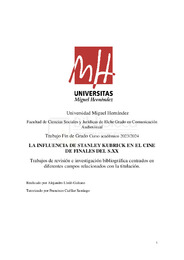Please use this identifier to cite or link to this item:
https://hdl.handle.net/11000/33351Full metadata record
| DC Field | Value | Language |
|---|---|---|
| dc.contributor.advisor | Cuéllar Santiago, Francisco | - |
| dc.contributor.author | Lledó Galiano, Alejandro | - |
| dc.contributor.other | Departamentos de la UMH::Ciencias Sociales y Humanas | es_ES |
| dc.date.accessioned | 2024-10-01T13:31:40Z | - |
| dc.date.available | 2024-10-01T13:31:40Z | - |
| dc.date.created | 2024-06 | - |
| dc.identifier.uri | https://hdl.handle.net/11000/33351 | - |
| dc.description.abstract | Desde sus humildes inicios con los hermanos Lumière, el cine ha ido evolucionando hasta convertirse en el gran entretenimiento de masas que conocemos hoy en día. A lo largo del tiempo, el cine se ha transformado en forma y técnica, pasando del blanco y negro al color, de las películas mudas a las sonoras y de planos estáticos a sofisticados movimientos de cámara. Estos avances y cambios se han producido debido a la influencia de generaciones de directores pioneros, quienes dejaron una importante herencia a las camadas de cineastas posteriores. Dentro de los grandes autores del cine, Stanley Kubrick destaca como una figura trascendental, quien, gracias a su meticulosa atención al detalle, su estética visual y la iconicidad de su cine, ha dejado una huella imborrable en el cine moderno, siendo una figura de gran influencia para cineastas posteriores. | es_ES |
| dc.description.abstract | From its humble beginnings with the Lumière brothers, cinema has evolved into the mass entertainment we know today. Throughout the ages, cinema has transformed in both form and technique, moving from black and white to colour, from silent films to sound films, and from static shots to sophisticated camera movements. These advances and changes have been due to the influence of generations of pioneering directors, who left an important legacy to later generations of filmmakers. Among the great film auteurs, Stanley Kubrick stands out as a transcendental figure, who, thanks to his meticulous attention to detail, his visual aesthetics and the iconicity of his cinema, has left an indelible mark on modern cinema, being a figure of great influence for later filmmakers. | es_ES |
| dc.format | application/pdf | es_ES |
| dc.format.extent | 33 | es_ES |
| dc.language.iso | spa | es_ES |
| dc.publisher | Universidad Miguel Hernández de Elche | es_ES |
| dc.rights | info:eu-repo/semantics/openAccess | es_ES |
| dc.rights | Attribution-NonCommercial-NoDerivatives 4.0 Internacional | * |
| dc.rights.uri | http://creativecommons.org/licenses/by-nc-nd/4.0/ | * |
| dc.subject | cine | es_ES |
| dc.subject | referente | es_ES |
| dc.subject | estética | es_ES |
| dc.subject | técnica | es_ES |
| dc.subject | fotografía | es_ES |
| dc.subject | cinema | es_ES |
| dc.subject | model | es_ES |
| dc.subject | aesthetic | es_ES |
| dc.subject | technique | es_ES |
| dc.subject | photography | es_ES |
| dc.subject.other | CDU::7 - Bellas artes::77 - Fotografía. Cinematografía | es_ES |
| dc.title | La influencia de Stanley Kubrick en el cine de finales del s. XX | es_ES |
| dc.type | info:eu-repo/semantics/bachelorThesis | es_ES |

View/Open:
Lledó Galiano, Alejandro.pdf
1,78 MB
Adobe PDF
Share:
.png)
